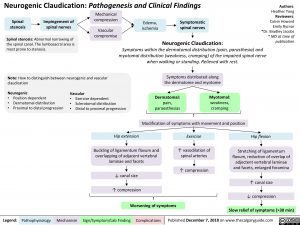Neurogenic Claudication: Pathogenesis and Clinical Findings Mechanical
Authors: Heather Yong Reviewers: Calvin Howard Emily Ryznar *Dr. Bradley Jacobs * MD at time of publication
Spinal Impingement of stenosis spinal nerves
Spinal stenosis: Abnormal narrowing of the spinal canal. The lumbosacral area is most prone to stenosis.
compression
Vascular compromise
Edema, ischemia
Symptomatic spinal nerves
Neurogenic Claudication:
Note: How to distinguish between neurogenic and vascular claudication
Symptoms within the dermatomal distribution (pain, parasthesia) and myotomal distribution (weakness, cramping) of the impaired spinal nerve when walking or standing. Relieved with rest.
Symptoms distributed along the dermatome and myotome
Neurogenic
• Position dependent
• Dermatomal distribution
• Proximal to distal progression
Vascular
• Exercise dependent
• Sclerotomal distribution
• Distal to proximal progression
Hip extension
Buckling of ligamentum flavum and overlapping of adjacent vertebral laminae and facets
↓ canal size ↑ compression
Worsening of symptoms
Myotomal:
weakness, cramping
Dermatomal:
pain, paraesthesias
Modification of symptoms with movement and position
Exercise
↑ vasodilation of
spinal arteries ↑ compression
Hip flexion
Stretching of ligamentum flavum, reduction of overlap of adjectent vertebral laminae and facets, enlarged foramina
↑ canal size
↓ compression
Slow relief of symptoms (>30 min)
Legend:
Pathophysiology
Mechanism
Sign/Symptom/Lab Finding
Complications
Published December 7, 2018 on www.thecalgaryguide.com
Foundations
Systems
Other Languages
Neurology Spine Diseases Neurogenic Claudication: Pathogenesis and Clinical Findings Neurogenic Claudication: Pathogenesis and Clinical Findings

